Intel Xeon E-2176G Benchmarks
For this exercise, we are using our legacy Linux-Bench scripts which help us see cross-platform “least common denominator” results we have been using for years as well as several results from our updated Linux-Bench2 scripts. At this point, our benchmarking sessions take days to run and we are generating well over a thousand data points. We are also running workloads for software companies that want to see how their software works on the latest hardware. As a result, this is a small sample of the data we are collecting and can share publicly. Our position is always that we are happy to provide some free data but we also have services to let companies run their own workloads in our lab, such as with our DemoEval service. What we do provide is an extremely controlled environment where we know every step is exactly the same and each run is done in a real-world data center, not a test bench.
We are going to show off a few results, and highlight a number of interesting data points in this article.
Python Linux 4.4.2 Kernel Compile Benchmark
This is one of the most requested benchmarks for STH over the past few years. The task was simple, we have a standard configuration file, the Linux 4.4.2 kernel from kernel.org, and make the standard auto-generated configuration utilizing every thread in the system. We are expressing results in terms of compiles per hour to make the results easier to read:
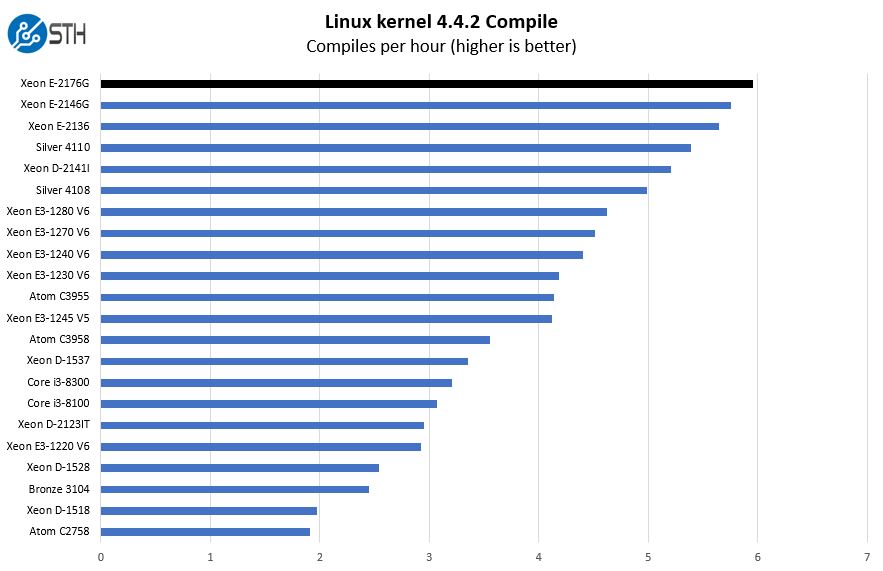
High clock speeds and more cores allow this to not only pull away from the top-end SKUs of the previous generation but also the 8-core Intel Xeon Silver CPUs and 16 core Intel Atom C3000 parts. That is extremely impressive given this chip’s price point.
c-ray 1.1 Performance
We have been using c-ray for our performance testing for years now. It is a ray tracing benchmark that is extremely popular to show differences in processors under multi-threaded workloads. We are going to use our 8K results which work well at this end of the performance spectrum.
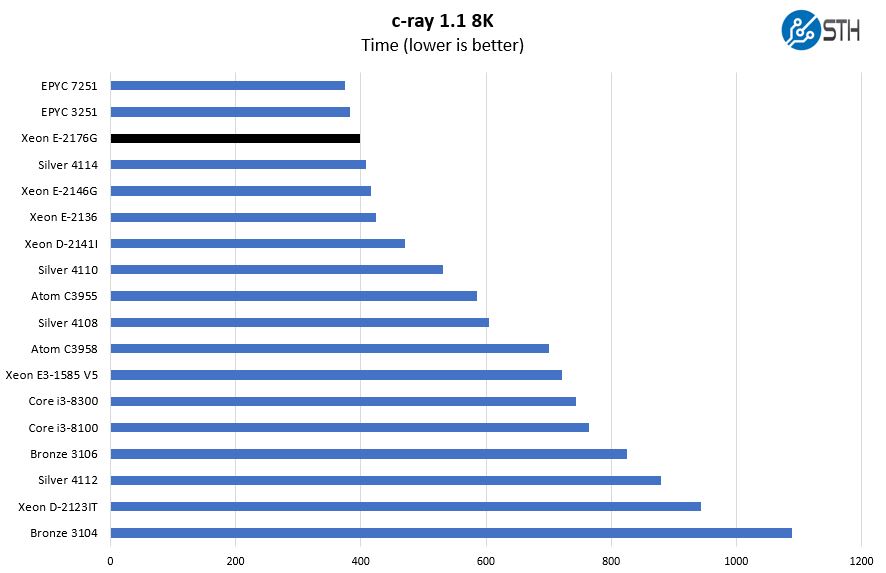
When writing this review, I asked about some of the numbers in our database. The Intel Xeon E3-1200 V6 line was launched in Q1 2017. Our 8K render was introduced later in 2017 along with the AMD EPYC and Intel Xeon Scalable launches. Instead, we included data from current generation CPU options. You can see that the high clock speeds allow these chips to be competitive with lower clocked Intel Xeon Silver 10 core parts and the 8 core AMD EPYC offerings. AMD performs extremely well in this benchmark.
7-zip Compression Performance
7-zip is a widely used compression/ decompression program that works cross-platform. We started using the program during our early days with Windows testing. It is now part of Linux-Bench.
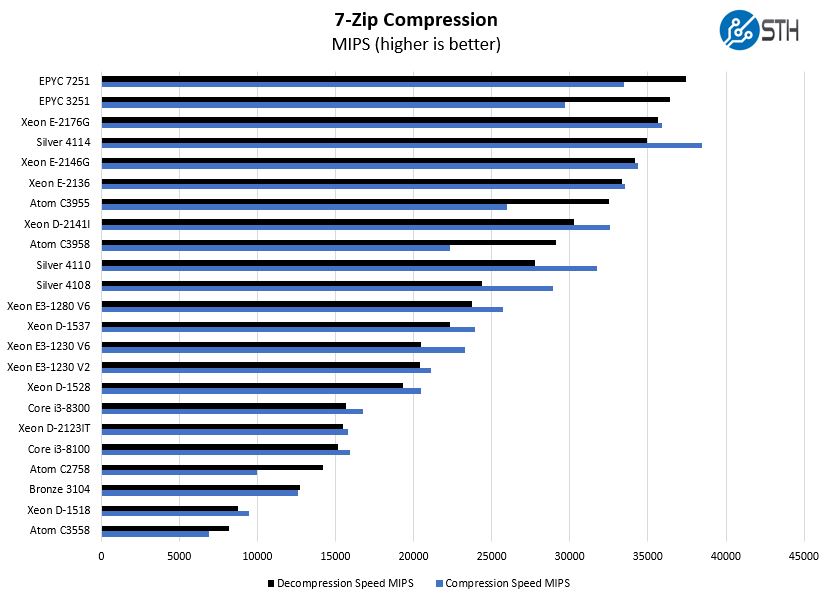
This is sorted by decompression per our custom. I wanted to quickly point out the huge gap from the Intel Xeon E3-1200’s of yesteryear. You can see the Xeon E3-1230 V2 to Xeon E3-1230 V6 which spans performance improvements from 2012 to 2017. Then look at the 2017 to 2018 improvement in the Intel Xeon E3-1280 V6, a more expensive part to the Intel Xeon E-2176G and you will quickly see the enormous jump this generation made in a relatively short time.
NAMD Performance
NAMD is a molecular modeling benchmark developed by the Theoretical and Computational Biophysics Group in the Beckman Institute for Advanced Science and Technology at the University of Illinois at Urbana-Champaign. More information on the benchmark can be found here. We are going to augment this with GROMACS in the next-generation Linux-Bench in the near future. With GROMACS we have been working hard to support Intel’s Skylake AVX-512 and AVX2 supporting AMD Zen architecture. Here are the comparison results for the legacy data set:
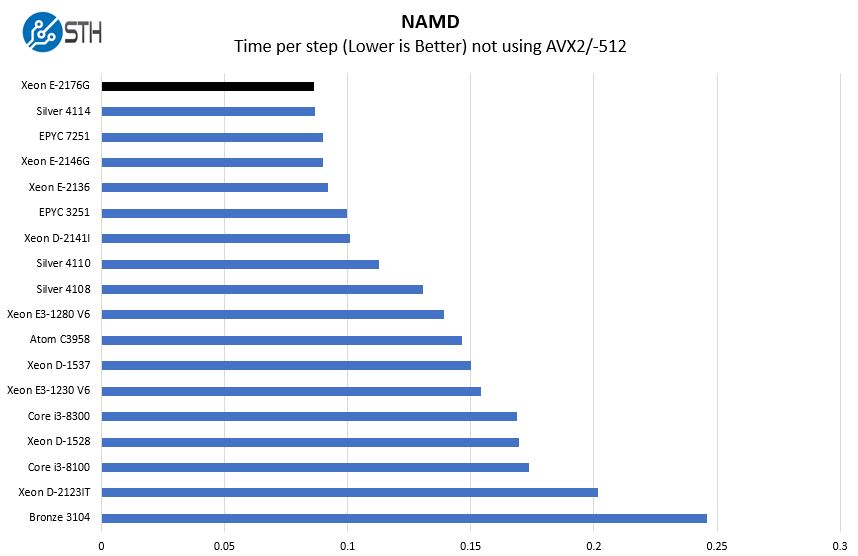
High clock speeds again allow the Intel Xeon E-2176G to perform above its price range here. One should be mindful that the other server platforms all have better server features so this is not a clear win.
Sysbench CPU test
Sysbench is another one of those widely used Linux benchmarks. We specifically are using the CPU test, not the OLTP test that we use for some storage testing.
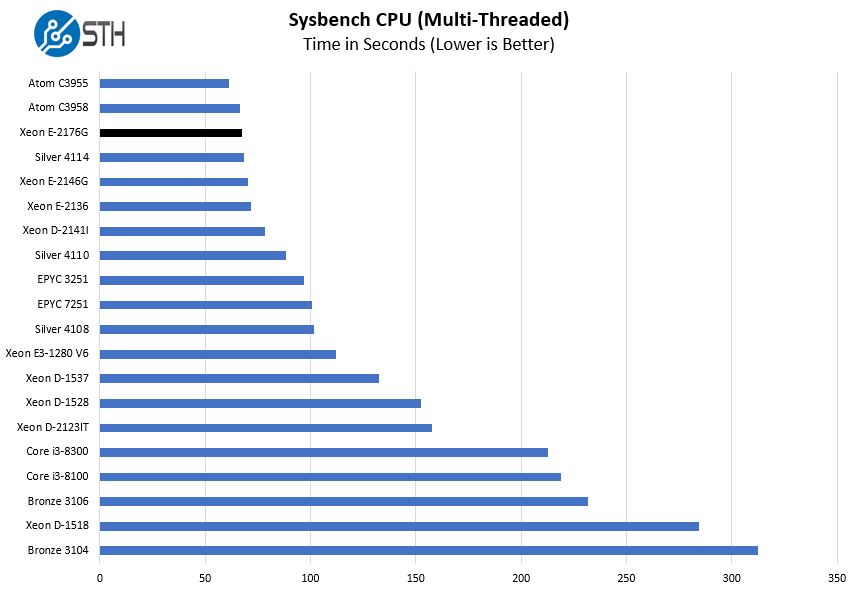
It takes a lot of cores to push bast the clock speed advantage the Intel Xeon E-2176G has. This is why we see these chips in a lot of dedicated hosting environments. They are inexpensive and offer great value, especially on otherwise marginally configured servers.
OpenSSL Performance
OpenSSL is widely used to secure communications between servers. This is an important protocol in many server stacks. We first look at our sign tests:
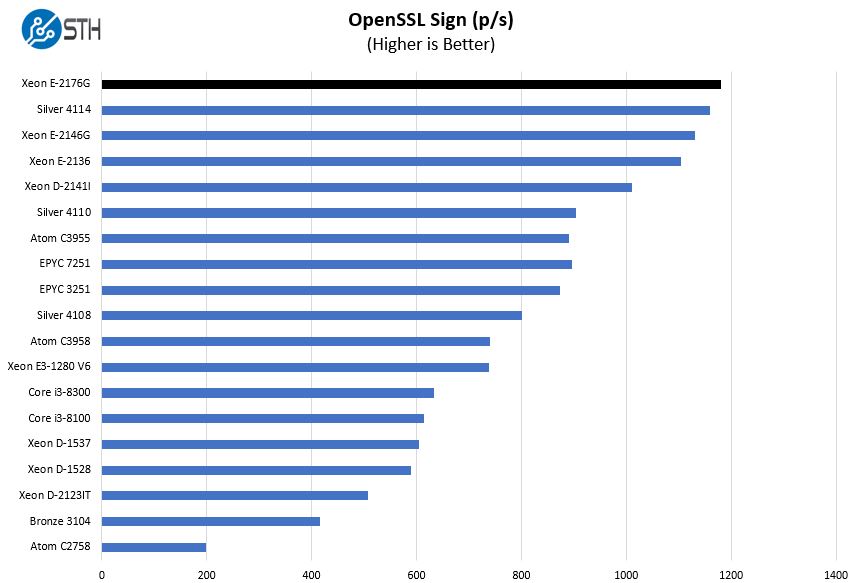
Here are the verify results:
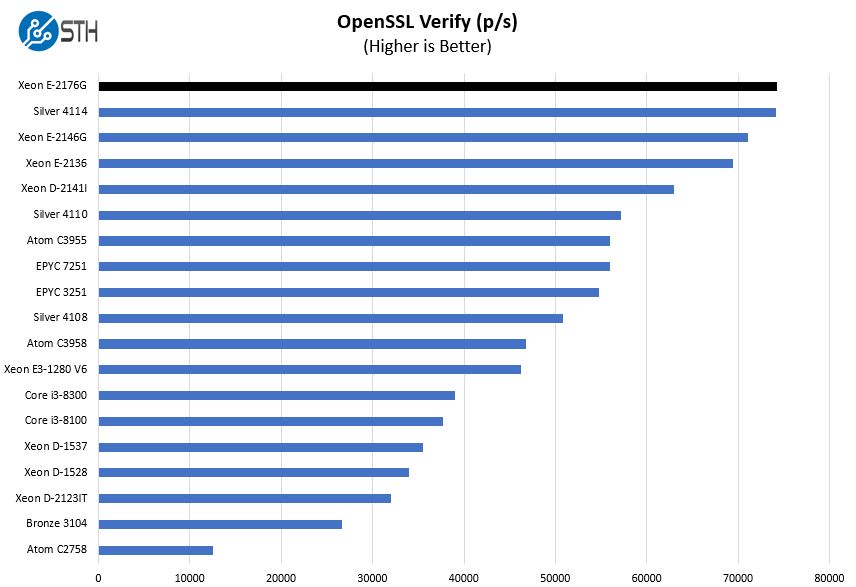
OpenSSL is a foundational web technology. Improved microarchitecture and high boost clock speeds again propel this chip.
UnixBench Dhrystone 2 and Whetstone Benchmarks
Some of the longest-running tests at STH are the venerable UnixBench 5.1.3 Dhrystone 2 and Whetstone results. They are certainly aging, however, we constantly get requests for them, and many angry notes when we leave them out. UnixBench is widely used so we are including it in this data set. Here are the Dhrystone 2 results:
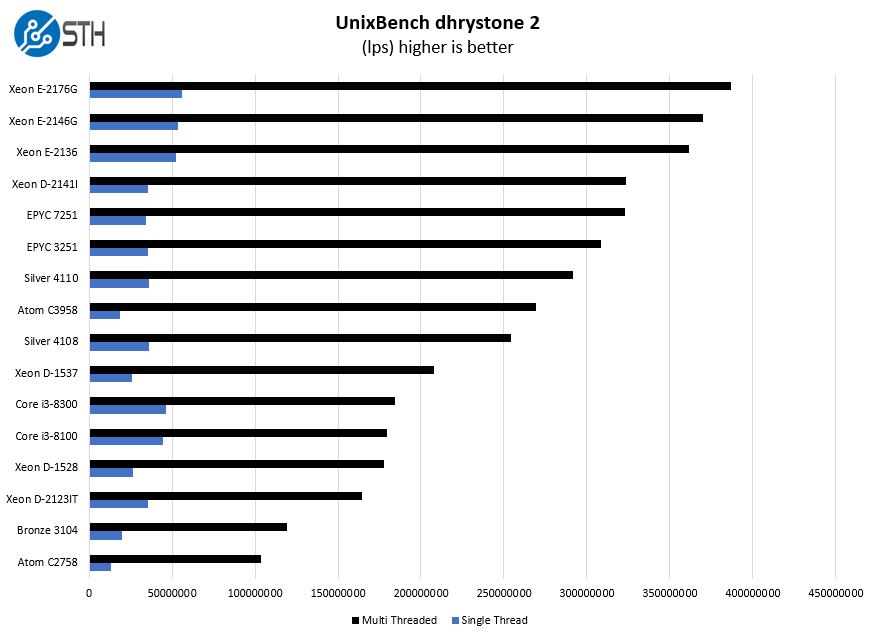
Here are the whetstone results:
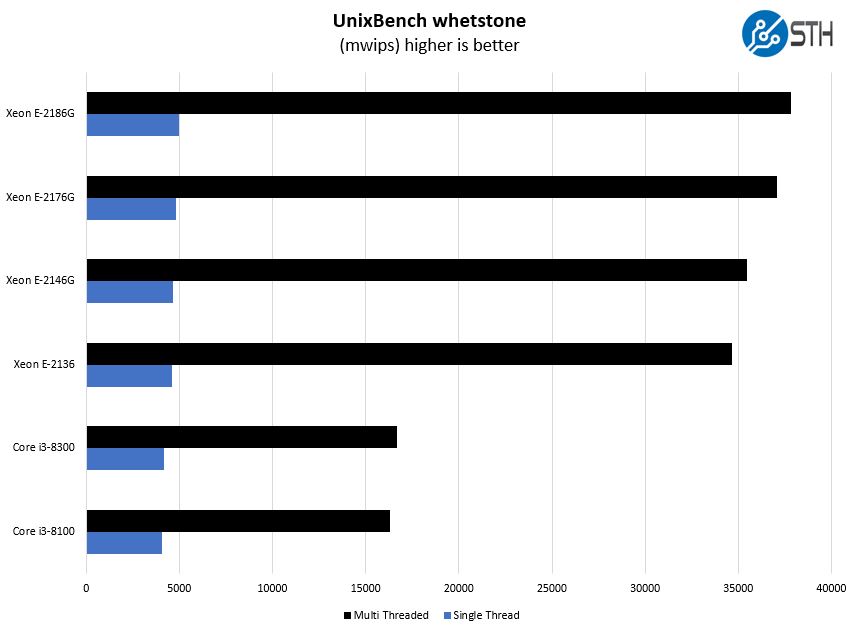
For our UnixBench results, I wanted to spice it up. Here we have a large comparison set on the UnixBench dhrystone 2 results while the whetstone we are showing all of the socket compatible options we have tested to date. We are using this to show two points:
- The single and multi-threaded performance is excellent with these chips.
- There is a wide variety of options that can be put in these systems.
For those looking at a standard hosting form factor, there is a lot of flexibility in CPUs which can save $200 or more on one end or provide significant performance on the other. You may also notice that we have the Intel Xeon E-2186G in the second chart. I wrote this article and while STH was waiting to publish it, we got hit by the Intel Xeon E-2100 Server Re-Launch and voluntarily held it. I used the opportunity to sneak another result in.
GROMACS STH Small AVX2/ AVX-512 Enabled
We have a small GROMACS molecule simulation we previewed in the first AMD EPYC 7601 Linux benchmarks piece. In Linux-Bench2 we are using a “small” test for single and dual socket capable machines. Our medium test is more appropriate for higher-end dual and quad socket machines. Our GROMACS test will use the AVX-512 and AVX2 extensions if available.
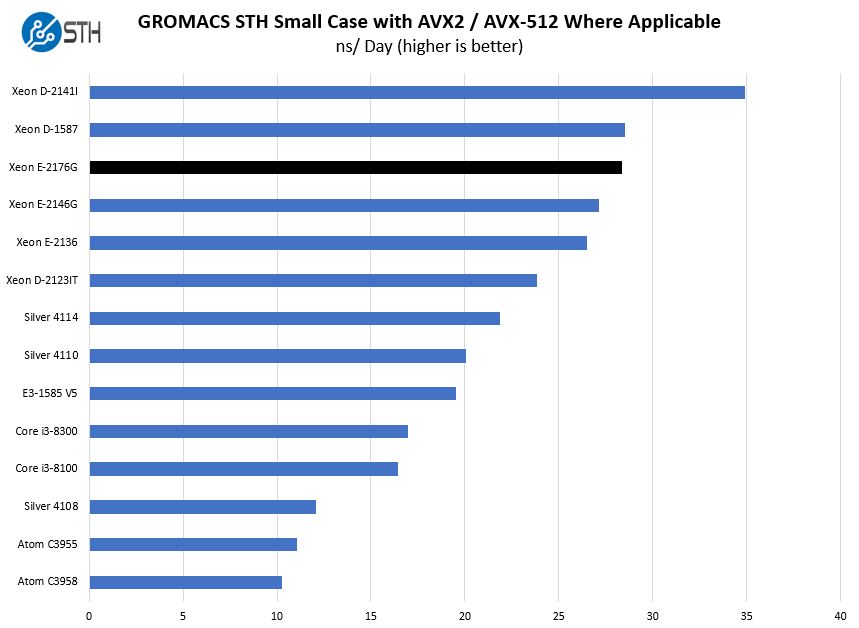
If you are building a dedicated hosting service, there is one other aspect to consider. Chips like the Intel Xeon E-2176G hold clock speeds higher in more workloads. That allows more consistent AVX2 performance since the chips are not down-clocking by a large amount.
Chess Benchmarking
Chess is an interesting use case since it has almost unlimited complexity. Over the years, we have received a number of requests to bring back chess benchmarking. We have been profiling systems and are ready to start sharing results:
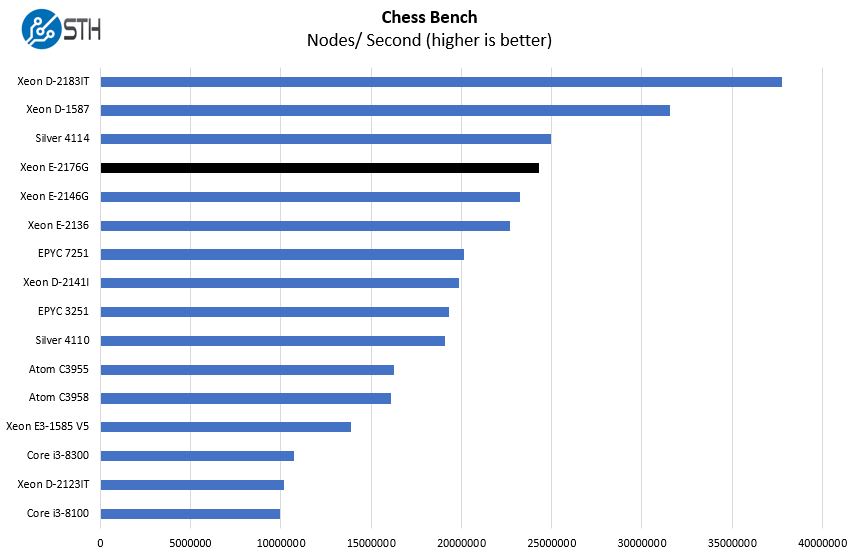
Again higher clocks allow these chips to play above the normal performance bands we see for higher-end server parts.
Next, we are going to have the power consumption, market positioning, and our final words.




No AVX-512 means you cannot benefit from optimizations from that codepath.
It’s unclear to me which OpenSSL version STH did use and if it included support for it; and which versions have been used in the past, to compare. From what I can tell using numbers of my servers with a D-15xx, STH’s neither supported it nor did STH use the more relevant to today’s market ‘ecdsap256’ for benchmarking signing and verifying .